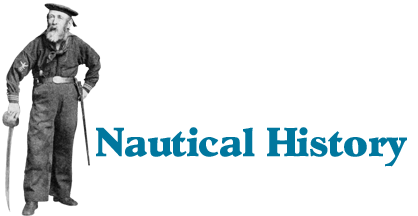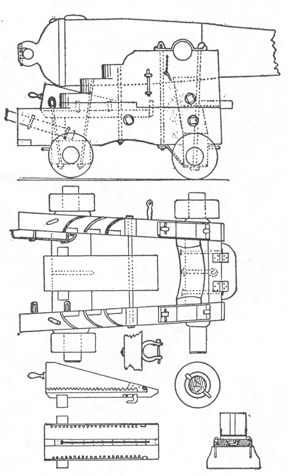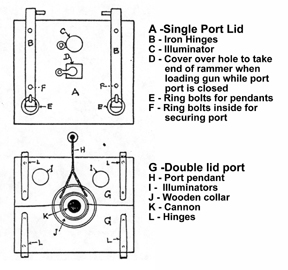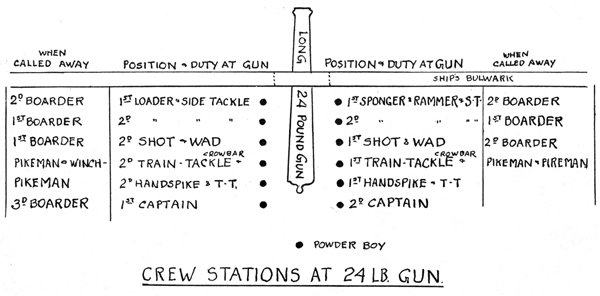

Gun Drill
By Jim Mathews
| 1. Broadside Carriage Guns | |||||||
 |
These guns like the others to be discussed here are designated by the weight of the solid ball ammunition used. For example: if the ball weighs six pounds, the gun is designated as a 6 pdr.--nine pounds—9 pdr. and so on through 12 pdrs, 18 pdrs, 24 pdrs and 32 pdrs. There was also a 36 pdr. used in the French naval service. The largest guns of this period were the 42 pdrs found in coastal fortifications and in some major warships. The six to twenty-four pound gun was in common use depending upon the size of the vessel and the 24 pdr. broadside gun and the 32 pdr. Carronade are what we will deal with in discussing the broadside action. The broadside guns were manufactured in three lengths; short, medium, and long; the long guns being the most accurate and long ranging. Long guns were sought out and used primarily for warships, while the short and medium guns were used for privateers and merchant vessels that routinely ventured into pirate waters like the British East and West Indiamen. These ships carried extremely valuable cargoes and needed significant armament to pass safely through the Eastern Seas. The Short and Medium barreled weapons were often referred to as "Cannonades" and had a tendency to "jump" upon firing when they were hot, after a few rounds had been put through them. These above weapons were all mounted on typical wheeled sea carriages whose design adapted the gun very well to the ship's structure. The gun had two projections, from the barrel, about midway between the muzzle and the breech of the gun, one on each side of the barrel, which were called "trunnions." These trunnions fitted into half holes cut into the top of the carriage, which carried the immediate weight of the barrel. When the gun was "seated" in the carriage, the trunnions were fitted into the half holes or "trunnion slots." The trunnions were then covered over the top half of the trunnion with a "cap screw" which effectively locked the gun into the carriage. This capscrew still allowed the gun to be elevated or depressed for the purpose of ranging. Training the gun as well as moving the entire gun and carriage had to be done by handspike. | ||||||
| 2. Chase Guns | |||||||
|
These
guns, as the name implies, were used in the chase of another vessel or
when being chased, in turn, and the best of these were either 9 pdrs, on
smaller vessels or 18 pdrs on larger warships. These weapons were
usually precision bored, and were always "long" guns.
They were as accurate a gun as was available in the period. They
were mounted in the bows and the stern of a ship, and were mounted on
sea carriages, as with broadside guns. Both Chase Guns and
Broadside Guns were counted in the calculation of the ships
"rate" and the weight of her broadside. The U.S. ships
of the period were very similar in "rate" to the British
vessels as indicated below. For example: -- A Fifth Rate British ship (heavy frigate) included those with two gun decks and the number of guns from 32 to 44. A Sixth Rate British ship (light frigate) would have a single gun deck and 20 to 28 guns. The rate was written as a frigate (38), or frigate (24). A 9 pdr. frigate's (24) guns would mean that she could throw a broadside of 108 pounds (9 pounds x 12 guns). This broadside weight was generally used to determine which ships could be attacked and which ships should be left alone. Obviously a vessel throwing a 108 lb. broadside would wish to think twice before taking on a warship throwing a 288-pound broadside (frigate 32--18 pdr). There were of course other considerations such as rate of fire and maneuvering ability, not to mention the experience of the captain, and the handiness of the crew, but the weight of broadsides was a major consideration. Three broadsides in five minutes were considered to be the mark of a very well worked up ship, and few warships attained such. |
|||||||
| 3. Carronades | |||||||
| These guns were called "Smashers" and they were developed very late in the Revolutionary War period at a foundry in Carron Scotland, hence the name. They were a short-range gun. However they could deliver a heavy ball for the weight of the barrel. The gun rested on a slide carriage and was mounted with a "mounting block" cast on the bottom of the gun instead of trunnions. The barrel was very light in comparison to a long gun and could do significant damage at short range. They were cast in 9 pdr., 12 pdr., 18 pdr., and 32 pdr. weapons and did not count in the ships rate. However, virtually every warship in the Spanish, Dutch, British, French and American navies carried them. There was also a variation of the Carronade called the "Gunade" which was a very similar gun except it was mounted on a sea carriage instead of a slide carriage and used trunnions instead of the mounting block. The "Gunade" was almost totally confined to merchant ships and privateers. Another advantage of the Carronade / Gunade was that it required a much smaller crew. | |||||||


 |
|||||||
| For the purposes of this treatise we will not deal with ordnance from the "monkeytail" swivel up to the 6pdr long gun. Nor will we deal with the Naval Mortar, which was often a valuable addition to a single ship, or a specially designed "mortar-ship" to a fleet charged with special duties. These are smaller and more specialized ordnance and had a variety of uses aboard ship. They can be dealt with in another discussion. While in the next section we will discuss gun crew action, we will consider the 24 pdr. Broadside Long Gun and the 32 pdr. Carronade only. It will be understood that the smaller guns did not need the large crews due to the weight of the gun, primarily. However, a description of the duties of each of the gun crews will serve to familiarize you with the many considerations in firing and preparing to fire warship's guns of this period. | |||||||
| Crew Stations | |||||||
|
Draw two lines
across the page about 1/4 of an inch apart leaving some space for
writing above the lines and about 10 times that much space below the
lines. In the vertical
center of the page, at right angles to the double lines draw a cannon
barrel that extends about halfway through both of the parallel lines
with the muzzle pointing at the top of the page.
The two parallel lines are the ship's bulwark or side, and the cannon
barrel represents one gun. Label between the parallel lines
"ship's bulwark" and label the gun barrel "long 24 pound
gun." To the right of the gun barrel and above the bulwark lines write the following, "Position and Duty At Gun." To the right of that statement write "When Called Away." Below the bulwark lines draw one vertical line that will separate the two above titles into information columns. |
|||||||
 |
|||||||
|
Under
"Position and Duty At Gun", beneath the bulwark lines, make
the following vertical list of positions and mark each position
beginning with a dot, thusly: •1st Sponger
& Rammer & Side Tackle (S.T.), •2nd Boarder; The above lists
indicate the required gun crew for a 24-pound long gun. Obviously a
12-pound gun would not require such a large crew.
The side columns indicate the additional positions for gun
crewmembers should the Captain call for boarders or for a fire team.
Using the right hand columns as an example let us now move to the
left side of the gun barrel and under the title of the column above the
bulwark lines, "Position and Duty At Gun" below the bulwarks
lines let us put down the following list: •1st Loader and
S.T.; •Powder Boy. To the left of the
above list and the vertical line separating the columns under the title
"When Called Away" and beneath the double bulwark lines write
the following list of positions matching the top position with the top
position of the above list: •2nd Boarder; *Winchman--To attend the main winch to haul an enemy ship in to close proximity, to man the capstan, etc. |
|||||||
 |
|||||||
   |
|||||||
|
To better
understand the handling of guns, the men employed and the instruments
used, let me quote the manual exercise: 1."Silence!
Man the Starboard (or Port) guns!" At this preparatory
order the strictest silence is to be observed.
The Gun Captain faces the gun muzzle; the men on the right and
left stand facing the gun; all fix thier eyes on the Captain and attentively wait for
orders. 2."Cast
Loose and Provide!" The Gun Captain
commands, sees his gun cleared and cast loose, portlid unbarred ready
for tricing up, or half ports taken out*, side and train tackles hooked
to the side training bolts, and the train-tackle to the eyebolt in the
rear of the gun; casts loose and middles breaching and places selvage
straps and toggles amidships; takes off the lock cover, hands it to the
train tackleman, who places it amidships; buckles on his waist belt;
(with a frog for a pistol, and with it cartridges and percussion caps
and a box containing fifty primers, fitted to a slip on the waist belt),
provides himself with a priming wire (vent pricker), puts on a secures
his thumb stall; sees that the gear and implements for the service of
the gun are all in place and ready for use, and that the men are
properly equipped *usually
upper deck guns have two-piece portlids and lower deck guns have one
piece portlids Second Gun Captain
assists in casting loose and middling breeching; takes off and places
amidships sight covers, selvage straps, and toggles; handles quoin;
provides thumb-stalls*, priming wires, and boring bitt (vent auger),
linstock (properly armed with slow match and lit)
and equips himself with the first two; clears the lock string,
and lays it in a loose coil round the lock, convenient for use, and
buckles on his waist belt, furnished the same as the First Captain's.
If the gun is furnished with an elevating screw, elevates the gun
that the lower half port may be let down. *thumbstall--a
leather thumb protector to cover the thumb when when sealing the touchhole
on a hot gun First Loader, aided
by the First Sponger, casts loose port-lanyard, removes upper half port
and passes it to the men on the left side of the gun, who lay it
amidships, lets down the half port.
On the lower deck, he casts off port lanyards and mizzen
lashings; removes the port bar and passes it to the men at the left side
of the gun, who lays it amidships; bears out (opens) port.
On all decks, places handswabs and chocking-quoin near the ship's
sides on the left side of the gun, aids First Sponger in taking the
tompion out of the muzzle of the gun. Second Loader aids
in casting loose; sees the wads in place, and for rifled cannon places a
pot of grease at hand; hooks outer block of side tackle to side training
bolt, on the left side of the gun. First Sponger casts
loose port-lanyards and aids First Loader in removing upper half port
and letting down lower ones, and on lower decks, in removing port bar,
bearing out the port and taking off the muzzle lashings; takes out the
tompion and passes it to the Second Sponger, who hangs it amidships;
places chocking quoin on the right side of the gun near the ship's side. Second Sponger
assists in casting loose, hooks outer blocks of sidetackle to side
training bolt on the right side of the gun. The Spongers take
down the sponges and rammers, take off the sponge cap and hang it out of
the way; place sponges and rammers together on the right side of the
gun; heads toward the breach in the brackets overhead on covered decks,
other wise on deck. The Side Tacklemen
assist in casting loose; on the lower decks, aid port-tacklemen. moisten
the sponge, being certain that the end of the sponge which touches the
bottom of the bore is thoroughly wet. Shellmen (Shot and
Wad) assist in casting loose, provide shot and wads, and proceed to the
hatchway, ready to pass loaded shell*; if ordered. *Shell--See
under shot below Train Tacklemen
lead out and hook train tackle. Handspikemen take
out the handspikes on their respective sides, and with gun carriages
using a quoin, each standing between his handspike and the side of the
ship, place the heel of their handspikes on the steps of the carriage
and under the breech of the gun, and raise it so that the quoin may be
eased and the lower half port be let down; or when housed the bed and
quoin be adjusted. Then,
each Handspikeman will lay his handspike on deck, on his own side of the
gun, parallel with its axis, clear of the trucks and butt to the rear. Powder Boy repairs
to his proper scuttle for his passing box, which having received he
returns and stands a little to the left and in rear of the gun; keeping
the passing box, under his left arm, and the cover closely pressed down
with his right hand. In the
passing box is the gunpowder cartridge. When there are fourteen or more
men at a gun, the Port Tackleman and Side Tacklemen, on lower decks,
lead out port tackle falls and assist in tricing up port, and when high
enough, belay the fall. NOTE-----Of course,
a 12-pound gun would not have this number of men, but the foregoing will
illustrate the work that had to be done.
A long 12-pounder's crew would have consisted of eight men and a
boy, and a long six pounder, six men and a boy. When the guns (12
pdrs) on both side of the ship were manned simultaneously, the First
Captain, Loader, Sponger and Handspikeman man the Starboard guns, and
the Second Captain, Loader, Sponger and Handspikeman the port guns, four
men to a gun. When only one
side is in use, all eight men man the gun. In Loading the Gun,
when it is run in as far as the breeching will permit, its muzzle is
only eighteen inches inboard, so the Sponger has to lean out of the port
to insert and manipulate the long handle of the Sponge. 3.
"Sponge Your Guns!" The First Sponger
rams the wet sponge down the barrel to the breech wetting the barrel,
and the Captain places his thumb over the touchole of the gun, while the
sponge is removed smartly thus creating a vacuum in the gun,
extinguishing any sparks left in the gun from a previous shot.
Obviously, this step is omitted at the first firing of the gun,
and is very important following the gun's firing. 3.
"Load Cartridge!" The Powder Boy
passes the powder charge from his passing box to the First Loader, who
places the powder charge (sewn up in a surge cartridge bag) into the
gun. 4.
"Ram Cartridge!" The First Rammer
rams the charge home to the Breech end of the cannon barrel. 5.
"Load Round (Ball or Shell)!" First Shot and Wad
Man passes the selected round and wad to the First Loader, who places
the round and wad in the gun barrel.
The wad is placed between the cartridge and the round. 6.
"Ram Round!" First Rammer rams
the Round and Wad against the charge (cartridge). The Gun Captain inserts the Priming Wire into the touchhole
making a hole in the Cartridge Bag, he then primes the gun either by
inserting a friction primer into the touchhole or by filling the touch
hole with Priming Powder from the Priming Horn at the gun. 7.
"Run Out" At the Command from
the Captain to "Run Out the Guns" the Side Tacklemen run the
guns up to the side of the ship, and the Gun Captain sights the gun,
elevating or depressing the gun barrel by use of the quoin or an
elevating screw. In the
case of the quoin, the Handspikemen eased (lift) the Breech of the gun
to allow proper placement of the Quoin. Training tackles and handspike
were also used to train the gun from side to side.
This action was not often needed since usually the guns fired
directly athwartships (broadside, hence the name), but in a chase
situation, for instance, the guns might be trained as far forward as
possible to get in a broadside shot without veering too far off course.
The same could be said for being chased and the guns trained aft.
This of course, depending upon the direction that the wind came
from. 8.
"Fire As Your Guns Bear!" At this command the
guns were fired. The gun
Captain warned his crew to "Clear The Gun" meaning that they
should stand clear, and fired the gun either by touching the smoldering
linstock to the fine priming gun powder in the touchhole, igniting the
friction primer by jerking the lanyard attached to it, or by activating
the firing lock (similar to a flintlock) attached to the gun barrel.
Generally, lock firing did not do well until the gun was hot, and
the linstock and powder train was used at first. This action was
determined by several possible additional commands as determined by the
ship's captain. If he wished to disable the opponent, he would have
instructed the Gun Captains to fire on an uproll to disable the rigging.
In this case he would have instructed that the guns be loaded with grape
or chain shot. If the
intention was to sink the opponent the guns would have been loaded with
solid shot and the gunners instructed to fire on the down roll in order
to hull the opponent. Shot / Rounds (type
of); Solid shot
determined the class of Gun, as a 24-pound cast iron ball was fired from
a 24 pounder cannon. Solid
shot were cast iron and were as the name implies solid. Grape was a round
with 9 small iron balls on a wooden form wrapped in canvas (This
resembled a cluster of grapes, hence the name).
When fired the canvas disintegrated and the balls were like a
shotgun charge. This is
very different from canister, which has many more small iron balls
packed in a cloth, leather or tin container with sawdust and is used
against personnel. Chain shot was
issued in a variety of forms: --a bag
containing an iron ring to which were fasted five 3 to 4 foot lengths
of chain, This was usually
known as "star shot;" All of these rounds
including grape were used to shred rigging. The solid shot was used to dismount enemy guns, and penetrate
the enemy hull. Shell was a hollow
cast iron sphere filled with gunpowder and separately fused.
It was tricky to use since the shell fuse was ignited by the fire
wash around the shell when fired. If
the shell was "short-fused" or the fuse was faulty, and the
round exploded in the barrel, it usually damaged the gun severely and
often the crew as well. As to the command
structure for firing the guns, the Gun Captains were experienced seamen
but were for the most part not petty officers.
For each "battery" of four guns there was usually a
Midshipman, or if not a Midshipman, a Gunner's Mate who was in charge of
the battery. His responsibility
was to see that all the equipment for the gun was in it's place and well
cared for, and his battle station was behind his guns for which he was
responsible. He passed the
word from the captain as to what rounds to load, where the target was,
and other information vital to the Gun Captains. The Gunner was a Senior Warrant Officer, and with his Mates, was responsible for making up charges, stowing ammunition, and looking after the gun carriages and the guns and all their related equipment. He was also responsible for any activity relating to the guns or gunpowder. His warrant was issued by the Ordnance Board in the British Navy not the Admiralty. |
|||||||
_________________
References:
"American Sailing Ships--Thier Plans and History," Charles G.
Davis, Dover Publications, New York, 1984;
"A Treatise of Artillery--1780," John Muller, Museum Restoration
Services, Alexandria Bay, New York;
"Naval Gun," Ian Hogg and John Batchelor, Blandford Press, Poole
Dorset, 1978;